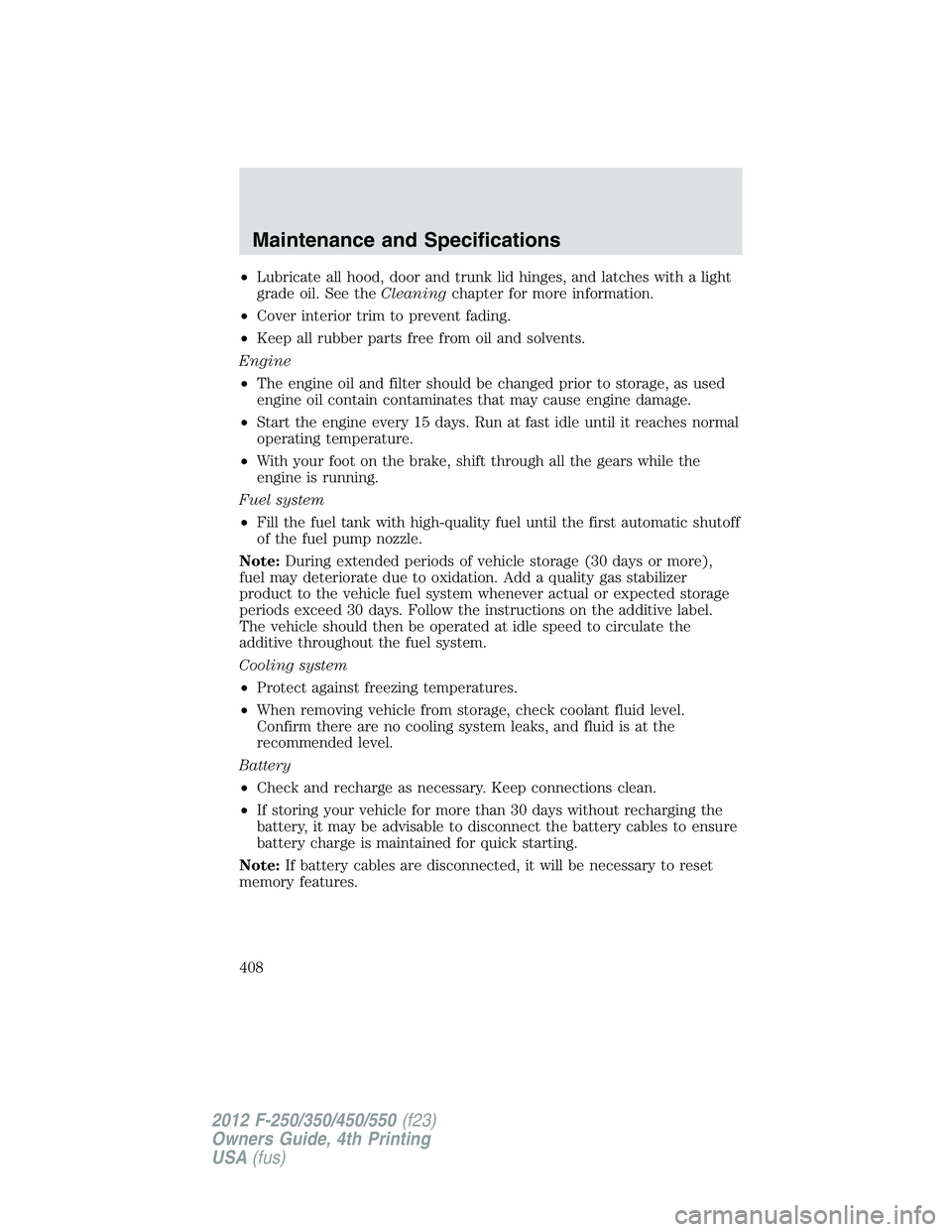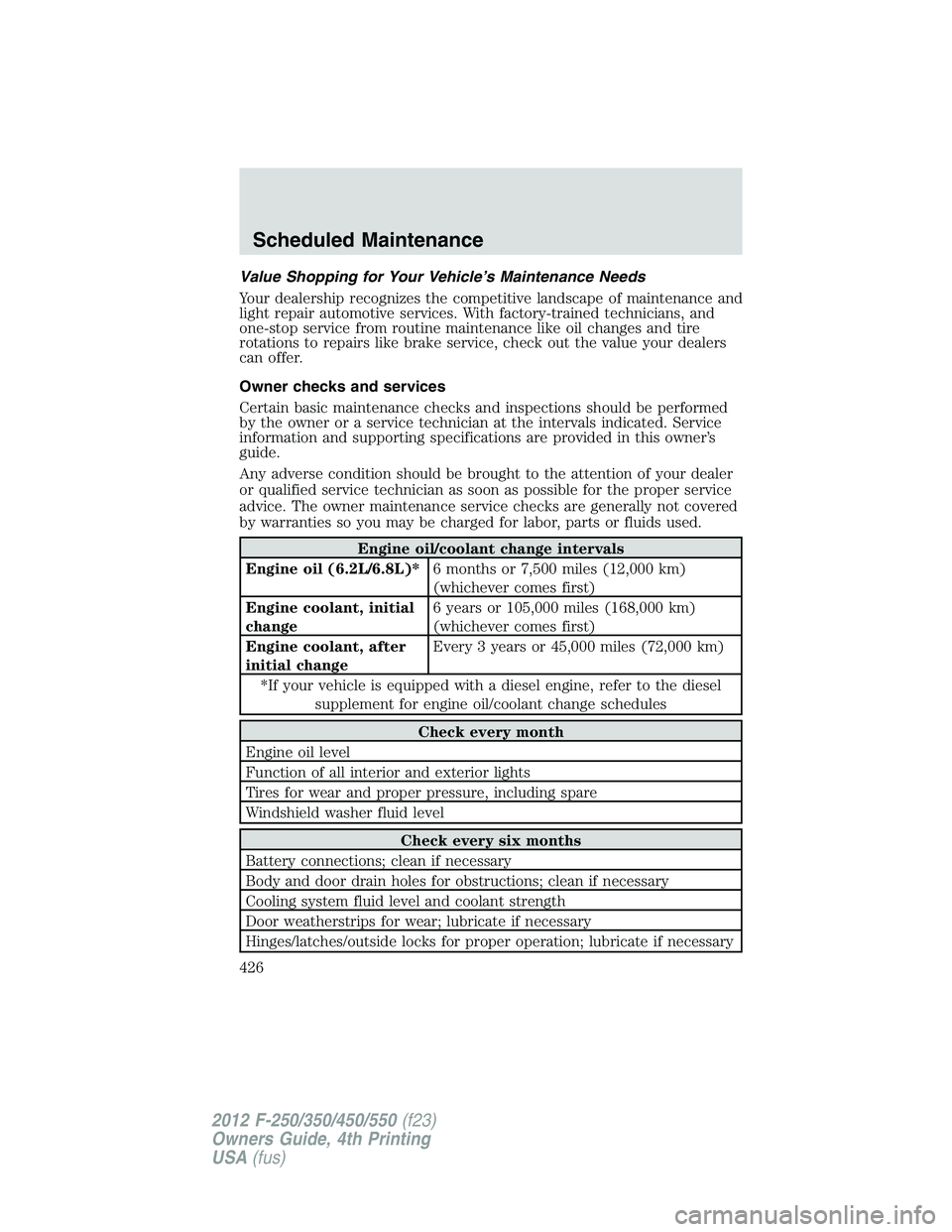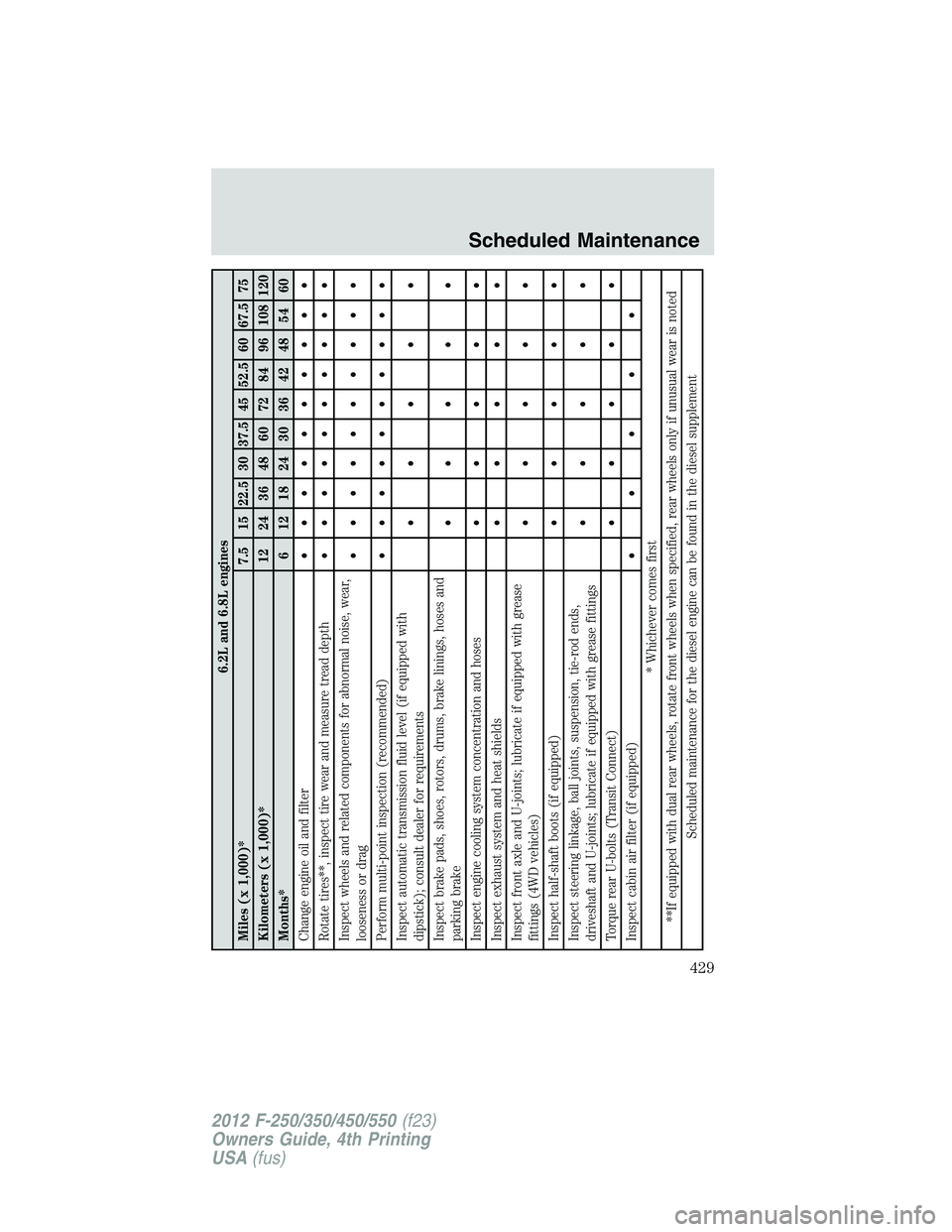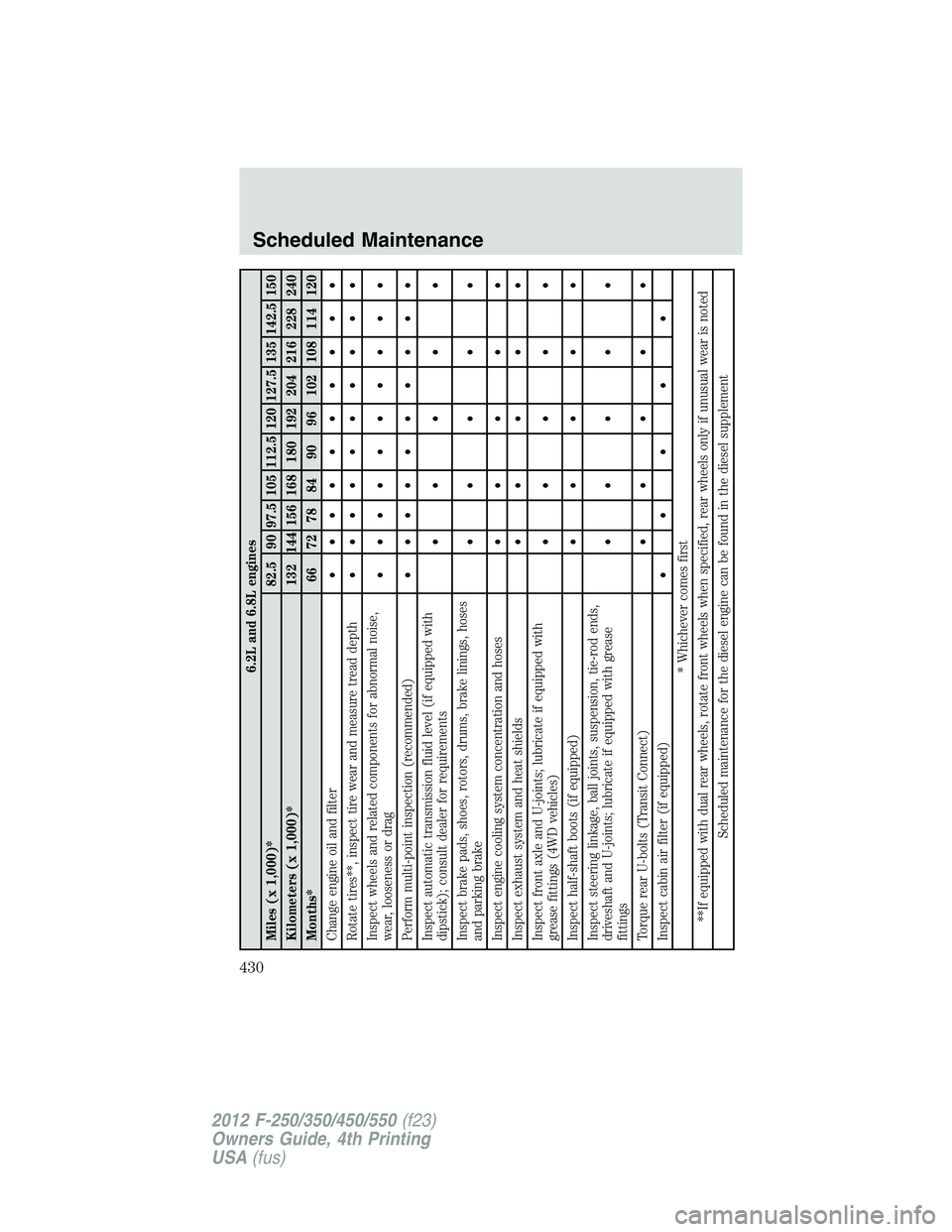2012 FORD F250 cooling
[x] Cancel search: coolingPage 384 of 448

What you should know about fail-safe cooling (if equipped)
If the engine coolant supply is depleted, this feature allows the vehicle to
be driven temporarily before incremental component damage is incurred.
The “fail-safe” distance depends on ambient temperatures, vehicle load
and terrain.
WARNING:If fail-safe cooling activates, pull off the road as
soon as safely possible and turn the engine off. The engine may
automatically shut off while driving without further indication.
How fail-safe cooling works
If the engine begins to overheat:
•The engine coolant temperature gauge will move to the red (hot)
area.
•The message center will indicate the engine is overheating.
•The service engine soon
indicator will illuminate.
If the engine reaches a preset over-temperature condition, the engine
will automatically switch to alternating cylinder operation. Each disabled
cylinder acts as an air pump and cools the engine.
When this occurs the vehicle will still operate. However:
•The engine power will be limited.
•The air conditioning system will be disabled.
Continued operation will increase the engine temperature and the engine
will completely shut down, causing steering and braking effort to
increase.
Once the engine temperature cools, the engine can be restarted. Take
your vehicle to an authorized dealer as soon as possible to minimize
engine damage.
When fail-safe mode is activated
You have limited engine power when in the fail-safe mode, so drive the
vehicle with caution. The vehicle will not be able to maintain high-speed
operation and the engine will run rough. Remember that the engine is
capable of completely shutting down automatically to prevent engine
damage; therefore:
1. Pull off the road as soon as safely possible and turn off the engine.
2. Arrange for the vehicle to be taken to an authorized dealer.
Maintenance and Specifications
384
2012 F-250/350/450/550(f23)
Owners Guide, 4th Printing
USA(fus)
Page 386 of 448

•the service engine soon indicator illuminates
1. Pull off the road as soon as safely possible and place the vehicle in P
(Park).
2. Leave the engine running until the coolant temperature gauge needle
moves away from the H range. After several minutes, if this does not
happen, follow the remaining steps.
3. Turn the engine off and wait for it to cool before checking the coolant
level.
WARNING:Never remove the coolant reservoir cap while the
engine is running or hot.
4. If the coolant level is normal, you may restart your engine and
continue on.
5. If the coolant is low, add coolant, restart the engine and take your
vehicle to an authorized dealer. SeeAdding engine coolantin this
chapter for more information.
Refer to fail-safe cooling for additional information.
FUEL FILTER
Your vehicle is equipped with a lifetime fuel filter (gasoline vehicles only)
that is integrated with the fuel tank. Regular maintenance or
replacement is not needed. For diesel engine information, refer to the
diesel supplement.
WHAT YOU SHOULD KNOW ABOUT AUTOMOTIVE FUELS
Important safety precautions
WARNING:Do not overfill the fuel tank. The pressure in an
overfilled tank may cause leakage and lead to fuel spray and fire.
WARNING:The fuel system may be under pressure. If the fuel
filler cap is venting vapor or if you hear a hissing sound, wait
until it stops before completely removing the fuel filler cap. Otherwise,
fuel may spray out and injure you or others.
Maintenance and Specifications
386
2012 F-250/350/450/550(f23)
Owners Guide, 4th Printing
USA(fus)
Page 408 of 448

•Lubricate all hood, door and trunk lid hinges, and latches with a light
grade oil. See theCleaningchapter for more information.
•Cover interior trim to prevent fading.
•Keep all rubber parts free from oil and solvents.
Engine
•The engine oil and filter should be changed prior to storage, as used
engine oil contain contaminates that may cause engine damage.
•Start the engine every 15 days. Run at fast idle until it reaches normal
operating temperature.
•With your foot on the brake, shift through all the gears while the
engine is running.
Fuel system
•Fill the fuel tank with high-quality fuel until the first automatic shutoff
of the fuel pump nozzle.
Note:During extended periods of vehicle storage (30 days or more),
fuel may deteriorate due to oxidation. Add a quality gas stabilizer
product to the vehicle fuel system whenever actual or expected storage
periods exceed 30 days. Follow the instructions on the additive label.
The vehicle should then be operated at idle speed to circulate the
additive throughout the fuel system.
Cooling system
•Protect against freezing temperatures.
•When removing vehicle from storage, check coolant fluid level.
Confirm there are no cooling system leaks, and fluid is at the
recommended level.
Battery
•Check and recharge as necessary. Keep connections clean.
•If storing your vehicle for more than 30 days without recharging the
battery, it may be advisable to disconnect the battery cables to ensure
battery charge is maintained for quick starting.
Note:If battery cables are disconnected, it will be necessary to reset
memory features.
Maintenance and Specifications
408
2012 F-250/350/450/550(f23)
Owners Guide, 4th Printing
USA(fus)
Page 426 of 448

Value Shopping for Your Vehicle’s Maintenance Needs
Your dealership recognizes the competitive landscape of maintenance and
light repair automotive services. With factory-trained technicians, and
one-stop service from routine maintenance like oil changes and tire
rotations to repairs like brake service, check out the value your dealers
can offer.
Owner checks and services
Certain basic maintenance checks and inspections should be performed
by the owner or a service technician at the intervals indicated. Service
information and supporting specifications are provided in this owner’s
guide.
Any adverse condition should be brought to the attention of your dealer
or qualified service technician as soon as possible for the proper service
advice. The owner maintenance service checks are generally not covered
by warranties so you may be charged for labor, parts or fluids used.
Engine oil/coolant change intervals
Engine oil (6.2L/6.8L)*6 months or 7,500 miles (12,000 km)
(whichever comes first)
Engine coolant, initial
change6 years or 105,000 miles (168,000 km)
(whichever comes first)
Engine coolant, after
initial changeEvery 3 years or 45,000 miles (72,000 km)
*If your vehicle is equipped with a diesel engine, refer to the diesel
supplement for engine oil/coolant change schedules
Check every month
Engine oil level
Function of all interior and exterior lights
Tires for wear and proper pressure, including spare
Windshield washer fluid level
Check every six months
Battery connections; clean if necessary
Body and door drain holes for obstructions; clean if necessary
Cooling system fluid level and coolant strength
Door weatherstrips for wear; lubricate if necessary
Hinges/latches/outside locks for proper operation; lubricate if necessary
Scheduled Maintenance
426
2012 F-250/350/450/550(f23)
Owners Guide, 4th Printing
USA(fus)
Page 429 of 448

6.2L and 6.8L engines
Miles (x 1,000)* 7.5 15 22.5 30 37.5 45 52.5 60 67.5 75
Kilometers (x 1,000)* 12 24 36 48 60 72 84 96 108 120
Months* 6 12 18 24 30 36 42 48 54 60
Change engine oil and filter• •••••••••
Rotate tires**, inspect tire wear and measure tread depth• •••••••••
Inspect wheels and related components for abnormal noise, wear,
looseness or drag• •••••••••
Perform multi-point inspection (recommended)• •••••••••
Inspect automatic transmission fluid level (if equipped with
dipstick); consult dealer for requirements•••••
Inspect brake pads, shoes, rotors, drums, brake linings, hoses and
parking brake•••••
Inspect engine cooling system concentration and hoses•••••
Inspect exhaust system and heat shields•••••
Inspect front axle and U-joints; lubricate if equipped with grease
fittings (4WD vehicles)•••••
Inspect half-shaft boots (if equipped)•••••
Inspect steering linkage, ball joints, suspension, tie-rod ends,
driveshaft and U-joints; lubricate if equipped with grease fittings•••••
Torque rear U-bolts (Transit Connect)•••••
Inspect cabin air filter (if equipped)• ••••
* Whichever comes first
**If equipped with dual rear wheels, rotate front wheels when specified, rear wheels only if unusual wear is noted
Scheduled maintenance for the diesel engine can be found in the diesel supplement
Scheduled Maintenance
429
2012 F-250/350/450/550(f23)
Owners Guide, 4th Printing
USA(fus)
Page 430 of 448

6.2L and 6.8L engines
Miles (x 1,000)* 82.5 90 97.5 105 112.5 120 127.5 135 142.5 150
Kilometers (x 1,000)* 132 144 156 168 180 192 204 216 228 240
Months* 66 72 78 84 90 96 102 108 114 120
Change engine oil and filter••••••••••
Rotate tires**, inspect tire wear and measure tread depth••••••••••
Inspect wheels and related components for abnormal noise,
wear, looseness or drag••••••••••
Perform multi-point inspection (recommended)••••••••••
Inspect automatic transmission fluid level (if equipped with
dipstick); consult dealer for requirements•••••
Inspect brake pads, shoes, rotors, drums, brake linings, hoses
and parking brake•••••
Inspect engine cooling system concentration and hoses•••••
Inspect exhaust system and heat shields•••••
Inspect front axle and U-joints; lubricate if equipped with
grease fittings (4WD vehicles)•••••
Inspect half-shaft boots (if equipped)•••••
Inspect steering linkage, ball joints, suspension, tie-rod ends,
driveshaft and U-joints; lubricate if equipped with grease
fittings•••••
Torque rear U-bolts (Transit Connect)•••••
Inspect cabin air filter (if equipped)•••••
* Whichever comes first
**If equipped with dual rear wheels, rotate front wheels when specified, rear wheels only if unusual wear is noted
Scheduled maintenance for the diesel engine can be found in the diesel supplement
Scheduled Maintenance
430
2012 F-250/350/450/550(f23)
Owners Guide, 4th Printing
USA(fus)
Page 443 of 448

LATCH .....................................206
recommendations ...................197
Child safety seats -
booster seats .............................212
Cleaning your vehicle
engine compartment ..............363
instrument panel ............365–366
interior .....................................367
plastic parts ............................364
safety belts ..............................367
washing ....................................361
waxing .....................................362
wheels ......................................362
wiper blades ............................364
Climate control (see Air
conditioning or Heating) ......78, 81
Clock ......................................61, 63
Compass, electronic
set zone adjustment .................27
Console ......................................100
overhead ..................................100
Controls
power seat ...............................159
steering column ......................112
Coolant ......................................379
checking and adding ..............379
refill capacities ................383, 411
Cruise control
(see Speed control) ..................110
Customer Assistance ................319
Ford accessories for your
vehicle .....................................369
Ford Extended Service
Plan ..................................421, 423
Getting assistance outside
the U.S. and Canada ..............357
Getting roadside assistance ...319
Getting the service you
need .........................................353Ordering additional owner’s
literature .................................359
Utilizing the
Mediation/Arbitration
Program ...................................357
D
Daytime running lamps
(see Lamps) ................................89
Defrost
rear window and rearview
mirrors .......................................81
windshield .................................81
Dipstick
automatic transmission
fluid ..........................................400
engine oil .................................375
Driving under special
conditions ..................295, 309, 312
sand .........................................311
snow and ice ...........................313
through water .................311, 315
E
Electronic message center ...22, 39
Emergencies, roadside
jump-starting ..........................348
Emergency Flashers .................320
Emission control system ..........396
Engine ........................................415
cleaning ...................................363
coolant .....................................379
diesel ...........................................7
fail-safe cooling .......................384
idle speed control ...................377
refill capacities ........................411
service points ..................371–373
Engine block heater .................269
Index
443
2012 F-250/350/450/550(f23)
Owners Guide, 4th Printing
USA(fus)
Page 444 of 448

Engine oil ..................................375
checking and adding ..............375
dipstick ....................................375
filter, specifications ........376, 410
recommendations ...................376
refill capacities ........................411
Event data recording ....................9
Exhaust fumes ..........................269
F
Fail safe cooling ........................384
Fleet MyKey programming ......129
Flexible Fuel Vehicle (FFV) ....386
Floor mats .........................122–123
Fluid capacities .........................411
Fog lamps ....................................88
Four-Wheel Drive vehicles .......301
driving off road .......................307
electronic shift ................301, 306
indicator light .........................302
lever operated shift ................303
manual locking hubs ..............301
preparing to drive your
vehicle .....................................285
Fuel ............................................386
calculating fuel
economy ............................25, 393
cap ...........................................389
capacity ...................................411
choosing the right fuel ...........390
detergent in fuel .....................392
filling your vehicle
with fuel ..................386, 389, 393
filter, specifications ................386
fuel pump shut-off ..................321
improving fuel economy ........393
octane rating ...................391, 415
quality ......................................391running out of fuel .................392
safety information relating
to automotive fuels ................386
Fuel - flex fuel vehicle
(FFV) .........................386, 390–391
Fuses ..................................321–322
G
Garage door opener ..................116
Gas cap (see Fuel cap) ............389
Gas mileage
(see Fuel economy) .................393
Gauges .........................................21
H
Hazard flashers .........................320
Headlamps ...................................87
aiming ........................................90
autolamp system .......................87
daytime running lights .............89
flash to pass ..............................88
high beam .................................88
replacing bulbs .........................94
turning on and off ....................87
Heating
heating and air conditioning
system .................................78, 81
Hill descent mode .....................281
Hill start assist ..........................294
Hood ..........................................371
I
Ignition ...............................265, 415
Illuminated visor mirror .............99
Index
444
2012 F-250/350/450/550(f23)
Owners Guide, 4th Printing
USA(fus)